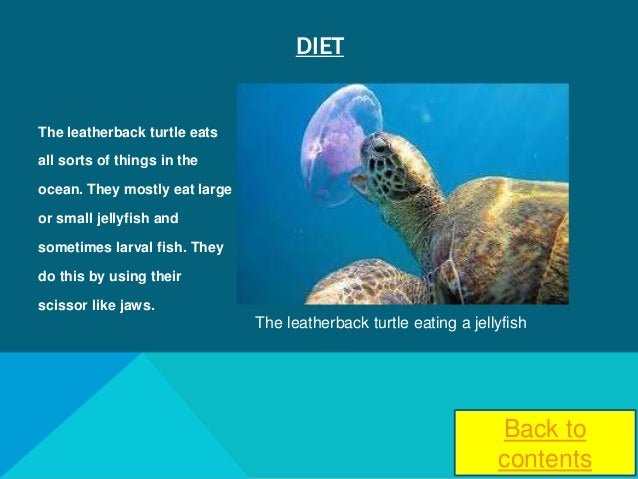
You might be thinking, “Jellyfish? Really?” It sounds a bit odd, but these creatures are surprisingly nutritious for leatherbacks, providing them with the energy they need to thrive in the ocean. Unlike other turtles that munch on grasses or crustaceans, leatherbacks are specialized for a different kind of feast. Let’s dive into their fascinating world of feeding habits and what keeps these magnificent turtles swimming strong.
What Do Leatherback Turtles Eat?
Leatherback turtles primarily feast on jellyfish, but their diet is not limited to just one type of food. They are known to consume a variety of marine creatures, including:
- Jellyfish
- Salps (gelatinous marine animals)
- Sea cucumbers
- Other soft-bodied animals
Leatherbacks have a specialized throat structure that helps them swallow their slippery food. Their tongues can push jellyfish and similar creatures down their throats, allowing them to consume large quantities at once. Imagine grabbing a handful of spaghetti and slurping it down—that’s a bit like how leatherbacks tackle their meals!
What’s fascinating is that while leatherbacks are primarily jellyfish eaters, they also play a crucial role in the ocean ecosystem. By consuming jellyfish, they help regulate jellyfish populations, which can otherwise balloon and disrupt marine ecosystems.
The Unique Adaptations of Leatherback Turtles
You might be wondering what makes leatherback turtles so well-suited for their jellyfish diet. Their anatomy is quite remarkable! Leatherbacks have a flexible, leathery shell instead of a hard one like other sea turtles, giving them better mobility in the water. This flexibility allows them to dive deep and hunt for their favorite food.
Additionally, leatherbacks possess long, narrow jaws equipped with pointed cusps. This unique mouth structure allows them to grasp slipper jellyfish effectively. Picture a pair of tweezers designed specifically for picking up tiny, wiggly snacks—this is how leatherbacks approach their meals!
Moreover, they are equipped with a highly developed sense of smell, which helps them detect prey from a distance. This means that even if the jellyfish are floating far away, a leatherback can still find them by sniffing out the scents in the water.
Feeding Strategies of Leatherback Turtles
Leatherback turtles use several strategies to find and consume their food. They are often seen swimming in open waters, where jellyfish tend to thrive. When hunting, they employ a method of “open-mouth foraging.” Here’s a breakdown of how it works:
1. Swimming Open-Mouthed: As they swim through the water, leatherbacks can open their mouths wide. This allows them to take in a large amount of water, along with their prey.
2. Filtering Prey: They then use their throat muscles to filter out water, trapping jellyfish and other soft-bodied animals inside.
3. Swallowing Prey Whole: Once they’ve collected enough food, they can swallow it all at once, allowing them to consume several jellyfish in a single gulp.
This feeding strategy is incredibly efficient and allows leatherbacks to consume massive quantities of jellyfish, sometimes up to 70% of their body weight in a single meal! That’s like an adult human eating nearly 140 pounds of food in one sitting.
Impact of Environmental Changes on Diet
Leatherback turtles face numerous threats that impact their feeding habits and overall diet. Climate change is one major factor affecting jellyfish populations. Warmer ocean temperatures can lead to increased jellyfish blooms, which might seem good for leatherbacks. However, these blooms can also lead to food shortages and competition for resources.
Additionally, pollution, particularly plastic waste, poses significant risks. Leatherbacks often mistake floating plastic bags for jellyfish, leading to ingestion that can cause internal blockages or even death. Remember, while they are excellent foragers, they’re also vulnerable to the changing environment around them.
This is why conservation efforts are so vital. Protecting both leatherbacks and their jellyfish prey ensures a healthy balance in the ecosystem.
Why Understanding Leatherback Diet Matters
So, why should we care about what leatherback turtles eat? Understanding their diet is crucial for several reasons. Firstly, it helps us appreciate the role they play in ocean ecosystems. By controlling jellyfish populations, leatherbacks contribute to the health of marine environments.
Secondly, knowing their feeding habits can help scientists and conservationists develop strategies to protect them. For instance, identifying critical feeding areas can lead to better management of marine habitats and reduced bycatch in fishing.
Finally, raising awareness about the threats leatherbacks face and the importance of their diet can inspire action. When people understand how interconnected marine life is, they’re more likely to engage in conservation efforts, such as reducing plastic use and supporting cleaner oceans.
Conservation Efforts for Leatherback Turtles
Conservationists are actively working to protect leatherback turtles and their habitats. This involves a variety of strategies, including:
- Establishing marine protected areas to preserve critical feeding grounds.
- Implementing regulations to reduce bycatch, particularly in fisheries targeting other species.
- Educating the public on the importance of reducing plastic waste to help decrease ocean pollution.
Each small step can contribute to the larger goal of ensuring that leatherback turtles continue to thrive. For example, community beach clean-up events not only reduce plastic waste but also raise awareness about the challenges these turtles face.
When we protect their feeding habitats, we’re also ensuring that future generations can marvel at these magnificent creatures.
The diet and feeding habits of the leatherback turtle are not just interesting facts; they’re a window into the complex interactions within our oceans. Understanding what they eat and how they find their food allows us to appreciate their role in maintaining the health of marine ecosystems.
So, the next time you think about these incredible creatures, remember: they are more than just jellyfish lovers. They are vital players in the oceanic dance of life and deserve our protection. By supporting conservation efforts, we can help ensure that leatherbacks continue to thrive in our oceans and inspire future generations with their beauty and grace.

